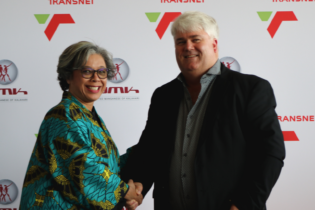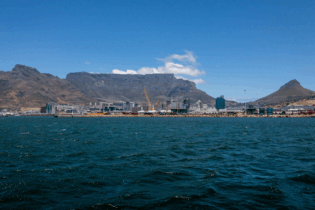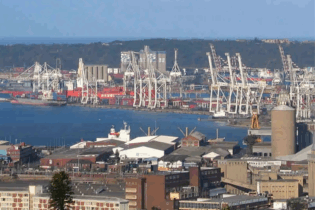Transport World Africa learns that infrastructure investments alone won’t improve efficiency at South Africa’s busiest port.
With modern road and rail infrastructure, the Port of Durban is the most popular, by usage, facility of its kind in South Africa. But, congestion, inefficiency, and costs remain major areas of concern, despite the incorporation of state-of-the-art traffic management systems, a world-class container scanner, and hi-tech cranes. Efforts have been, and continue to be, made to address these issues. For example, there are measures in place to separate traffic, with trucks travelling in one direction and small vehicles and contractors using different access and exit roads. The port’s entry and exit gates are opened and closed automatically, once the truck registration plates and transported container numbers captured electronically match. Trucks are then directed to one of three interchange zones in the port, depending on the type of transaction they’re completing. Everyone entering the terminal is breathalysed, while staff in the five-storey admin building monitor everything on screen, through strategically placed cameras. Big mouth Most of the investments made by Transnet, as part of its market demand strategy spend, in excess of R330 billion, have been in Durban. The harbour mouth at the port has been widened, from 120 m to 220 m, allowing an exchange of two vessels at any given time. The entry point has also been dredged to around 16 m, in order to handle larger vessels. Because parcel sizes get larger as vessels get bigger, there are plans to deepen the berths further. The moment that is done, shipping lines will want to do one-port calls on the South African seaboard, which affords Durban a very fortunate business opportunity to handle transshipments. Durban will have to handle transshipments if frequency of sail is desired. If this were to happen, Durban could be the Rotterdam of sub-Saharan Africa, which would be good news for the country. Currently, very little transshipment is being performed – that happens at Ngqura in the Eastern Cape. Cruise control A cruise terminal will be built in the next five years. Cruise liners are becoming increasingly popular, especially those travelling along the Indian Ocean routes during the summer seasons. Transnet believes Durban offers lots of choice in terms of its users’ operational needs, and how cargo is moved in and out of the port system. It says speed of delivery is at the cornerstone of what it does and, while that may be open to debate, it is mandated to offer a good freight logistics solution for all. Lift-off Seven new-generation cranes have been deployed on the north quay. These cranes, supplied by Shanghai Zhenhua Heavy Industry (ZPMC), are tandem lift units valued at around R300 million each. In operation since 2012, these are some of the biggest cranes in the Southern Hemisphere and were the first of their kind to be used in Africa.The ZPMC cranes can pick up four containers at a time, depending on the stow on the vessel and how the shipping line has stacked the load. The cranes make around 13 container moves an hour, and automatically stop when wind speeds exceed 70 km/h. Gusts of wind are a problem, especially when it comes to empty containers. The old cranes are to be dismantled and cut up.
However, only if plans are synchronised between the shipping lines, the port, and freight forwarders can these machines be optimally utilised. Cargo needs to be arranged on ships to be properly serviced in the port without delay, thereby reducing turnaround times. The booms on the cranes can reach twenty containers wide and can stack seven containers high. Removing and replacing a crane is a process that can take two to three months to complete. Two new cranes to be used on the east quay have recently been acquired, over and above the seven already used. The port handles around 5 000 containers per day, sending 743 on rail and over 2 600 by road. The north quay is to be expanded to the west by another 110 metres towards the sea. An environmental impact assessment is currently under way, as an ecosystem of frogs, fish, and birds has to be relocated. The expansion will be done to accommodate three vessels at any given time, up from the current two vessels. Stacking up The port authority is trying to free up space through the pyramid stacking of containers. Rubber tyred gantry cranes can stack a lot higher – as many as five containers high and sixteen across. This is a good system for exports, but not ideal for imports. If your container happens to be the one in the middle of a pyramid formation, it takes a number of moves to retrieve it. It is important for clearing and forwarding companies to supply complete paperwork so the boxes can be released and the relevant transporter allocated. Without this information, Pier 1 in Durban can become a very difficult terminal to operate. The main north precinct is one of the most competitively active parts of the port, with 15 berths in that area servicing bulk commodities and break bulk cargo. The sugar and wood chip industries are housed in this area. Durban’s total capacity for handling containers is 2.9 million TEUs a year, with Maydon wharf creating a further capacity of 200 000 TEUs as a relief valve. Every now and again, customs stops a container, wanting it to be scanned. There is a customs warehouse and SARS office, which houses the new container scanner – a world-class piece of equipment installed at the beginning of the year. While the port operates 24/7, warehouses only operate during the day. In this respect, industry and the port terminal need to align better. The City of Durban recently won the rights to host the 2022 Commonwealth Games and so much development is taking place in the city in preparation. While Durban has great infrastructure and the best operating equipment of South Africa’s ports, the terminal operator would do well to find ways to make it more efficient, by using what it has, in light of the weakening economic climate. Doing the numbers- The total distance around the Port of Durban is 21 km.
- Sixty percent of South Africa’s container imports and exports go through the port, making it the biggest terminal in South Africa.
- Eighty million tonnes of cargo is handled annually.
- There are 58 berths, 40 of which are commercial.
- Durban is the busiest port in Africa in terms of vessel calls, with more than 4 000 per annum.
- It is now the third busiest port in Africa; while it used to be the second busiest, it was recently overtaken by the port at Tangiers, which has grown 40% year-on-year. However, a lot of that is transhipment cargo.
- Durban is South Africa’s second most important economic complex after Johannesburg.
- It focuses on everything: containers, liquid bulk, cars, and the cruise industry.
- The total land and water area equals to 1 854 hectares. 120 000 trucks, 140 000 cars, and 200 000 pedestrians move through the port per month.








